I have a function that gives me the percentage of each row, but I cant plot the Table. My function is this:
porcentaje.preguntas <- df %>%
group_by(Localidad) %>%
select(Localidad, starts_with("X")) %>%
summarise(across(where(is.numeric), ~ scales::percent(mean(.x))))
And the output its something like this:
# A tibble: 309 x 73
Localidad X2.1 X2.2 X2.3 X2.4 X2.5 X2.6 X2.7 X2.8 X2.9 X2.1.1 X2.11 X2.12 X3.1 X3.2 X5.1 X5.2 X5.3
<chr> <chr> <chr> <chr> <chr> <chr> <chr> <chr> <chr> <chr> <chr> <chr> <chr> <chr> <chr> <chr> <chr> <chr>
1 0001CIUDA~ 100% 100% 100% 100% 100% 100% 100% 100% 100% 100% 100% 100% 100% 100% 100% 100% 100%
2 01001AGUA~ 100% 99% 99% 100% 100% 98% 100% 100% 100% 100% 100% 100% 100% 100% 100% 100% 100%
3 01003CALV~ 100% 100% 100% 100% 100% 100% 100% 100% 100% 100% 100% 100% 100% 100% 100% 100% 100%
4 01005JESÚ~ 100% 100% 100% 100% 100% 100% 100% 100% 100% 100% 100% 100% 100% 100% 100% 100% 100%
5 01006PABE~ 100% 100% 100% 100% 100% 89% 100% 100% 100% 100% 100% 100% 100% 100% 100% 100% 100%
6 01007RINC~ 100% 100% 100% 100% 100% 100% 100% 100% 100% 100% 100% 100% 100% 100% 100% 100% 100%
7 01011SAN ~ 100% 100% 100% 100% 100% 100% 100% 100% 100% 100% 100% 100% 100% 100% 100% 100% 100%
8 02001ENSE~ 100% 100% 100% 100% 100% 96% 100% 100% 100% 100% 100% 100% 100% 100% 99% 97% 100%
9 02002MEXI~ 100% 100% 100% 100% 100% 99% 100% 100% 100% 100% 100% 100% 100% 99% 99% 97% 100%
10 02003TECA~ 100% 96% 96% 100% 100% 78% 100% 96% 100% 100% 100% 100% 100% 96% 96% 100% 100%
# ... with 299 more rows, and 55 more variables
How Can I plot this Table with all the columns?

